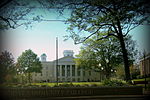Fourth Creek Congregation
Churches in Iredell County, North CarolinaIredell County, North CarolinaRowan County, North Carolina

The community of the Fourth Creek Congregation was a group of Scots-Irish Presbyterians who first arrived in the Province of North Carolina in the mid to late 1730s and established a congregation by 1750 under pastor John Thompson in Anson County which became Rowan County in 1753 and finally Iredell County in 1788. The site of the Fourth Creek Congregation was chosen as the location of the county seat of Iredell County in 1789 and was named Statesville in 1789. The Fourth Creek Presbyterian Church officially became the First Presbyterian Church of Statesville in 1875.
Excerpt from the Wikipedia article Fourth Creek Congregation (License: CC BY-SA 3.0, Authors, Images).Fourth Creek Congregation
West End Avenue, Statesville
Geographical coordinates (GPS) Address Nearby Places Show on map
Geographical coordinates (GPS)
| Latitude | Longitude |
|---|---|
| N 35.7855988 ° | E -80.891098 ° |
Address
West End Avenue 221
28677 Statesville
North Carolina, United States
Open on Google Maps











